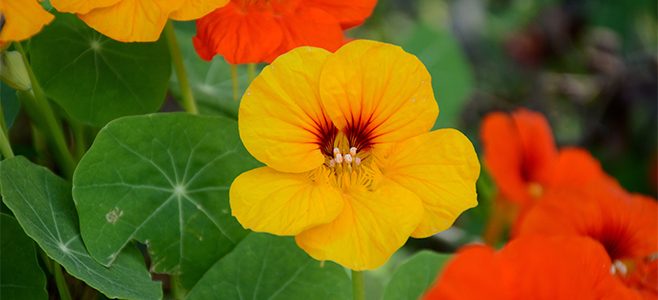
If you enjoy gardening, you’re probably aware of the benefits of companion planting. Companion planting is the practice of growing different plants together in combinations that make them more productive. This works when plants have complementary characteristics: for instance, some plants help other plants by naturally repelling pests, attracting pollinators, providing shade to plants in need of sun protection, acting as a support to climbing plants, suppressing weeds, or adding nutrients to the soil.
A classic example of beneficial companion planting by Native American communities is the “Three Sisters Trio” of corn, beans and squash. Planting these three plants together generally produces a better crop from all three because the tall corn supports the climbing beans, the beans provide nitrogen to the soil, and the wide, prickly leaves of the winter squash repels pests and shades the soil so it won’t dry out.
But does companion gardening benefit citrus plants, like orange trees and other citrus?
Companion Gardening with Citrus Trees
When it comes to tree care, citrus has one advantage: many citrus trees are self-pollinating, so you don’t need to plant more than one citrus tree in order to grow a crop of fruit. But this does not mean that citrus trees won’t benefit from companion planting…in fact, companion planting can help your citrus lime tree or other type of citrus tree stay healthy and yield more fruit.
Whether you buy dwarf citrus trees to keep in a container on your patio or buy citrus trees to plant in the ground if you live in the proper growing zone, here are three types of plants you may want to keep around them in order to help them be best citrus trees they can be:
Wildflowers
Why they’re good for your citrus tree: Wildflowers are wonderful companion plants for many gardens because they attract pollinators such as bees, butterflies and hummingbirds. Yes, we did say that citrus trees are self-pollinating, and that’s true insofar as you don’t need to plant more than one citrus tree in order to get fruit. But your tree will still pollinate far more efficiently if it gets help from those naturally occurring pollinators than if you rely on the wind (and it’s far easier than trying to pollinate the flowers yourself with a paintbrush!).
What kinds are best: One of the best things about using wildflowers as companion plants is that they’re pretty to look at and easy to grow, particularly if they’re native to the geographic location. Some great choices to go with your citrus tree or trees are echinacea (also known as coneflower), Queen Anne’s Lace, bee balm, and various types of daisies (including Black-Eyed Susans).
Herbs
Why they’re good for your citrus tree: Different types of herbs provide different benefits to your citrus tree, and indeed to many plants in your garden. Many of them are natural pollinators like the wildflowers listed above, but some go even further by repelling pests (like aphids, mites, and even rabbits and deer), adding nutrients to the soil around your citrus trees planted in the ground, or keeping the soil healthy.
What kinds are best: Herbs are a wonderful addition to any garden. Not only are many of them beautiful to look at, they often smell wonderful, repel biting pests like mosquitoes and ticks, and they can be used in cooking or making homemade cleaning products. Some that go well with citrus are lavender, rosemary, parsley, comfrey, chives, cilantro and chamomile.
Nasturtium
Why they’re good for your citrus tree: Citrus can attract aphids, but if you have nasturtium planted nearby, the pesky critters while almost certainly go for that instead. And nasturtium is so bright and pretty, with many colors and lovely leaves, you’ll be delighted to include it in your garden! Even better, the flowers are edible, making them a great addition to salads and as garnish for many main dishes and desserts.
A few things to keep in mind…
If you have a potted citrus tree, never plant companion plants in the container with the tree. Doing so could impede the tree’s growth due to root spacing. You can situate pots with companion plants in them around the potted citrus plant, however.
Also, when planting companion plants near your citrus tree, be sure to keep in mind which companion plants need full sun so you can plant them outside your citrus tree’s canopy. Some plants are fine in partial shade. Also, you should wait until your tree is at least three feet tall before planting companion plants near it to avoid them interfering with the roots of the young tree.

